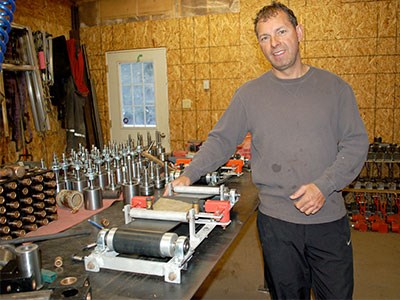A conveyor alignment system, designed and manufactured in Dave Sharp's backyard workshop, has found a home in several countries across the globe.
“It was a part-time thing because I just wanted to make the payments on a truck,” he said. “That's all I wanted to do.”
His company, Conveyors Plus, has been growing since he started about seven years ago. In 2011, he quit his technician job at a Timmins mine to devote his time to marketing, manufacturing and installing his product, the Sure Align Tracker.
“I worked on conveyors for 26 years and that's how I came up with the idea,” he said.
His system, which consists of five components, is self-correcting and guides the belt to proper alignment.
“Any rolling element on a conveyor belt that is not 90 degrees perpendicular to the belt is going to cause misalignment, so if I can change the angle, I am going to steer the belt,” Sharp said.
His system works on the return belt, the clean or under side part of the belt, which creates better contact for his steering roller which replaces a return roller. The existing return bracket bolt holes are utilized for easy and quick installation.
His miniature model of a conveyor, which he takes to trade shows, shows how the system works. The system is also standard for any size of belt, whether it is 120 or 14 inches in width.
“People look at the model and see it work and realize how simple the system is. They always say, 'why didn't I think of this?'”
While the steer rollers are purchased elsewhere, Sharp's brother makes the parts at his Timmins machine shop. Sharp does the welding and then paints the components after they are sandblasted and his two teenaged sons assemble them.
He is currently looking at having the parts manufactured elsewhere, and possibly casted, if the quality can be maintained.
He has patents in several countries and his products can be found in Canada, the U.S., Australia, South America and Africa. A large part of his clientele is in the mining industry, but others such as pulp and paper and aggregates have found a use for his system.
“I was in Chile recently and the conveyor was 14 kilometres long and has 25,000 rollers,” Sharp said. “That's about 100 million pieces of equipment but it eliminates the haul trucks coming from the open pit so that's a savings. But when the conveyor is down, that means production is stopped.”
The local mine he worked at was his first customer and he always had plans to take his system globally.
“I thought of Chile right away because of the large scale of their mines,” he said.
He used his holidays to travel the world doing installations and attending trade shows.
“I like the installation part and training the people because I go there and I am a hands-on person. I am not a salesman, but a tradesman, and I do have a lot of experience. I can help out with other things as well and I tell them that when I can,” Sharp said.
Other products are on the market but nothing quite like his system.
“I am often asked if I am worried about people copying me. I just know I have a good relationship with the people I work with and I have a good product that works well. That's how I got to here.”




